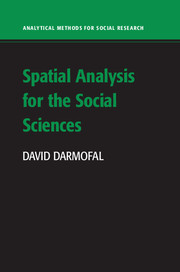Book contents
- Frontmatter
- Contents
- List of Figures
- List of Tables
- Preface
- PART I GENERAL TOPICS
- 1 The Social Sciences and Spatial Analysis
- 2 Defining Neighbors via a Spatial Weights Matrix
- 3 Spatial Autocorrelation and Statistical Inference
- 4 Diagnosing Spatial Dependence
- 5 Diagnosing Spatial Dependence in the Presence of Covariates
- 6 Spatial Lag and Spatial Error Models
- 7 Spatial Heterogeneity
- PART II ADVANCED TOPICS
- PART III APPENDICES ON IMPLEMENTING SPATIAL ANALYSES
- Glossary
- Bibliography
- Index
4 - Diagnosing Spatial Dependence
from PART I - GENERAL TOPICS
Published online by Cambridge University Press: 05 November 2015
- Frontmatter
- Contents
- List of Figures
- List of Tables
- Preface
- PART I GENERAL TOPICS
- 1 The Social Sciences and Spatial Analysis
- 2 Defining Neighbors via a Spatial Weights Matrix
- 3 Spatial Autocorrelation and Statistical Inference
- 4 Diagnosing Spatial Dependence
- 5 Diagnosing Spatial Dependence in the Presence of Covariates
- 6 Spatial Lag and Spatial Error Models
- 7 Spatial Heterogeneity
- PART II ADVANCED TOPICS
- PART III APPENDICES ON IMPLEMENTING SPATIAL ANALYSES
- Glossary
- Bibliography
- Index
Summary
Before modeling either of the two alternative sources of spatial dependence inherent in Galton's problem via a spatial lag or spatial error model, the researcher first has to determine whether her data exhibit spatial dependence. Is there spatial autocorrelation in the behavior or process the social scientist is seeking to explain? The first step in a spatial analysis involving areal data is to diagnose this spatial dependence in the absence of covariates. A variety of tests exist to diagnose univariate spatial autocorrelation in the absence of covariates. This chapter examines these tests and demonstrates how social scientists can employ them in their research.
The chapter is structured as follows. First, I examine global tests for spatial autocorrelation, which diagnose dependence in the data as a whole. Next, I examine local tests for spatial autocorrelation, which diagnose the particular units that are spatially autocorrelated with their neighbors (where neighbors are defined utilizing a neighbor definition such as those discussed in Chapter 2). Here, a particularly important class of statistics for local spatial autocorrelation, local indicators of spatial association (LISA) statistics, is examined in detail. The spatial dependence diagnosed via global and local measures of spatial autocorrelation may not reflect true spatial dependence, but instead, a second type of spatial effect, spatial heterogeneity. This spatial heterogeneity, the topic of Chapter 7, is examined briefly. The chapter concludes by discussing the global and local tests for spatial autocorrelation examined in this chapter and previewing the modeling of spatial dependence in Chapter 5. Throughout the chapter, diagnostics for spatial dependence are demonstrated utilizing a set of empirical applications to civil wars, poverty rates, partisan voting, and legislative roll-call voting behavior.
GLOBAL MEASURES OF SPATIAL AUTOCORRELATION
Tests for spatial autocorrelation in areal data can proceed at either the global or local levels. Tests for global spatial autocorrelation examine whether the data as a whole exhibit spatial autocorrelation (against a null of spatial randomness) as well as the strength and direction (positive or negative) of any spatial autocorrelation. Tests for local spatial autocorrelation (again, against a null of spatial randomness) identify particular observations that are autocorrelated with neighboring observations on the random variable of interest and also determine the strength and, depending on the statistic, also the direction of this spatial autocorrelation.
- Type
- Chapter
- Information
- Spatial Analysis for the Social Sciences , pp. 43 - 67Publisher: Cambridge University PressPrint publication year: 2015

